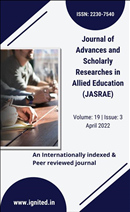Embroidering Sustainability: A Review of Practices Aimed at Uplifting Chikankari Artisans in Lucknow, Uttar Pradesh
Keywords:
Embroidering Sustainability, Chikankari, Artisans, Lucknow, Uttar PradeshAbstract
India is a major supplier of various handicrafts to the worldwide market. The Indian Chikankari business is highly esteemed in the worldwide handicraft market. This is an ancient culture and heritage of India that highlights many traditional arts from different parts of the country. Chikankari goods have a wide international market because of their growing potential. The Indian Chikankari industry is distinguished by its heavy dependence on manual labor and its decentralized structure, with production facilities situated in various rural and urban areas around the nation. The industry employs almost six million artisans, with a significant number being women and individuals from underprivileged groups. The Chikankari Sector exerts a significant and pivotal influence on the country's economy. The craft sector in rural and semi-urban regions provides employment to a substantial number of skilled workers and makes a considerable contribution to the country's foreign currency earnings, while also preserving its cultural heritage. Chikankari holds significant potential since it plays a vital role in sustaining the existing population of artisans across the whole country. Nevertheless, the substantial expansion of the Chikankari sector is accompanied by certain obstacles. The study highlighted the complexity and several obstacles associated with the Chikankari industry in India.
Downloads
References
Akhir, N. H. M., Ismail, N. W., Said, R., & Kaliappan, S. R. A. P. (2015). Traditional craftsmanship: The origin, culture, and challenges of batik industry in Malaysia. In Islamic perspectives relating to business, arts, culture and communication: Proceedings of the 1st ICIBACC 2014 (pp. 229-237). Springer Singapore.
Alexandri, M. B., Zultaqawa, Z., & Aulia, M. D. (2019). Creative industries: Strategy and challenges in the Craft Sub-sector. Review of Integrative Business and Economics Research, 8, 255-263.
Chudasri, D., Walker, S., & Evans, M. (2012). An overview of the issues facing the craft industry and the potential for design, with a case study in Upper Northern Thailand.
Dalal, A., Bhattacharya, S., & Chattopadhyay, S. (2021). Hurdles to handicraft marketing for artisan entrepreneurs in an emerging economy. Journal of Small Business and Enterprise Development, 31(1), 74-94.
Dash, M., & Mishra, B. B. (2021). Problems of handicraft artisans: an overview. International Journal of Managerial Studies and Research, 9(5), 29-38.
Datta, D. B., & Bhattacharyya, S. (2016). An Analysis on problems and prospects of Indian handicraft sector. Asian Journal of Management, 7(1), 5-16.
Dixit, A. (2015). Harbingers of Change Success Stories of Indian Social Entrepreneurs.
Hassan, R. (2007). Problems and Revival of Handicraft Industry in Kashmir-An Analysis. Education, 2011.
Kebede, A. A. (2018). Opportunities and challenges to highland bamboo-based traditional handicraft production, marketing and utilization in Awi Zone, Northwestern Ethiopia. International Journal of History and Cultural Studies, 4(4), 57-67.
Kumar, D., & Rajeev, P. V. (2013). Present scenario of Indian handicraft products. Asian Journal of Managerial Science, 2(1), 21-27.
Kumar, V., Kumari, P., Yadav, P., & Kumar, M. (2021). Ancient to contemporary—The saga of Indian handloom sector.
Mukami, N. S. (2012). Response strategies adopted by handicraft traders in Kenya to challenges of exporting (Doctoral dissertation).
Navaratne, T. L., & Ratnayake, R. M. A. K. (2015). Sustainability of Small Scale Traditional Industries in Sri Lanka–With Specific Reference to the Handicraft Industry. Volume IV, 214.
Pant, S. C., & Pandey, M. (2015). Supply chain challenges: a case study of Uttarakhand woolen handicraft industry. International Journal of Management, IT and Engineering, 5(6), 140-155.
Shafi, M., Yin, L., & Yuan, Y. (2021). Revival of the traditional handicraft enterprising community in Pakistan. Journal of Enterprising Communities: People and Places in the Global Economy, 15(4), 477-507.
Shah, A., Patel, R., & Vidyapith, R. (2018). Problems and Prospects of Rural Handicraft Artisans. Rajiv Patel Research Guru: Online Journal of Multidisciplinary Subjects (Peer Reviewed), 12.
Shakya, R. (2018). A Study on Export Challenges of Handicraft Industry in Kathmandu (Doctoral dissertation, Department of Management).
Topimin, S. (2015). Government intervention in women entrepreneurship development: Opportunities and challenges for Bumiputera women entrepreneurs (BWEs) in the handicraft industry in Malaysia. Nottingham Trent University (United Kingdom).
Tripti, S. (2020). Socio-economic Status of Chikan workers of Lucknow. Voice of Intellectual Man-An International Journal, 10(1and2), 85-110.
Yang, Y., Shafi, M., Song, X., & Yang, R. (2018). Preservation of cultural heritage embodied in traditional crafts in the developing countries. A case study of Pakistani handicraft industry. Sustainability, 10(5), 1336.











